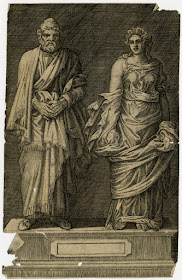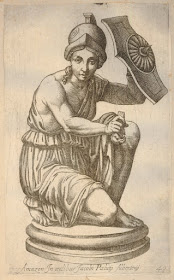 |
| Bust from Alexandria Zeus Serapis 1st century BC bronze British Museum |
 |
| Bust excavated in Rome Hercules 2nd century BC marble British Museum |
When the Emperor Hadrian lay dying in AD 138 he supposedly uttered a short poem. It appears below in several different English translations, extending over several centuries.
 |
| John Skippe Two Herms ca. 1781-83 chiaroscuro woodcut British Museum |
 |
| John Skippe Two Herms ca. 1781-83 chiaroscuro woodcut British Museum |
My little wandring sportful Soule,
Ghest, and companion of my body
– John Donne, 1611
 |
| Jacopo Tintoretto Bust of Vitellius mid-16th century drawing British Museum |
 |
| Jacopo Tintoretto Bust of Vitellius mid 16th century drawing British Museum |
My soul, my pleasant soul and witty,
The guest and consort of my body,
Into what place now all alone
Naked and sad wilt thou be gone?
No mirth, no wit, as heretofore,
Nor Jests wilt thou afford me more.
– Henry Vaughan, 1652
 |
| Sir Thomas Reeves Dancing Faun ca. 1744-88 etching British Museum |
 |
| Sir Thomas Reeves Dying Gladiator ca. 1744-88 etching British Museum |
Poor little, pretty, fluttering thing,
Must we no longer live together?
And dost thou prune thy trembling Wing,
To take thy Flight thou know'st not whither?
Thy humorous Vein, thy pleasing Folly
Lyes all neglected, all forgot;
And pensive, wav'ring, melancholy,
Thou dread'st and hop'st thou know'st not what.
– Matthew Prior, 1709
 |
| Giulio Bonasone Bust of Athena ca. 1531-76 engraving British Museum |
 |
| Giulioi Bonasone Antique Bust of Jupiter ca. 1531-76 engraving British Museum |
 |
| Nicolas Beatrizet Antique Bust of Titus Livy 1572 engraving British Museum |
Ah! gentle, fleeting, wav'ring sprite,
Friend and associate of this clay!
To what unknown region borne,
Wilt thou, now, wing thy distant flight?
No more, with wonted humor gay,
But pallid, cheerless, and forlorn.
– George Gordon, Lord Byron, 1806
 |
| Marcantonio after Raphael Apollo in niche ca. 1512-15 engraving British Museum |
 |
| circle of Michelangelo Studies of an antique statue 16th century drawing British Museum |
Little soul so sleek and smiling
Flesh's guest and friend also
Where departing will you wander
Growing paler now and languid
And not joking as you used to?
– Stevie Smith, 1966
 |
| Giuseppe Maria Mitelli Man Destroying Statue 17th century drawing Morgan Library, New York |
 |
| Giuseppe Maria Mitelli Man destroying statue ca. 1678-80 engraving British Museum |
"Easy to destroy a statue, but not to make one."










































